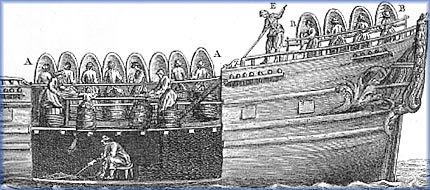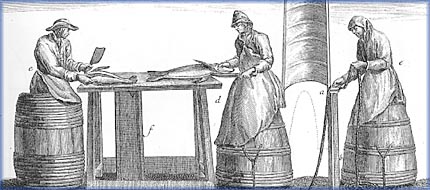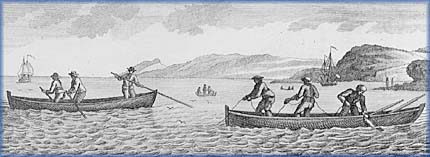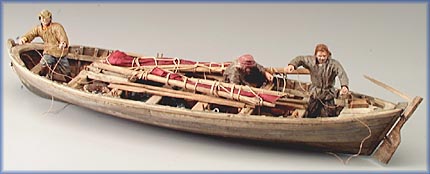|
The Fishermen
|
|
|
A Day in the Life of a Fisherman :
|
The Grand Bank Fishery - In
the bank fishery, the fishermen stood in barrels that were
secured to the deck.
Wearing a long leather apron, they released their lines, which
were weighted with 2.3 kilos of lead and had one or two baited
hooks. When they felt a cod bite, they hauled it up on deck,
removed the tongue and set it aside. The tongues were counted
to determine each fisherman's catch.
The header and the splitter worked opposite each other at a
table. An apprentice took the cod to the header, who removed
the head and gutted the fish. A boy deposited the liver in a
barrel. The splitter then split the cod open, removed the
backbone and threw the fish into the hold, where the salters
packed it between two layers of salt.
|

|
|
Fishing for cod on the banks (detail), 18th century
From Traité général des pesches,
by Duhamel du Monceau, 1772
(National Library of Canada)
|

|
|
Fishing and preparing green cod on the banks,
18th century
The fishermen stand in barrels to maintain their balance and protect
themselves from the cold and humidity. From right to left: a fisherman;
the header, who removed the head and gutted the cod; and the splitter,
who split the cod open and removed the backbone.
From Traité général des pesches,
by Duhamel du Monceau, 1772
(Canadian Museum of Civilization)
|
|
The Shallop Fishery - The
shallops went out around three o'clock in the morning, carrying
a crew of three men. If the wind was favourable, the men hoisted
the sail, but they often had to row both ways.
When cod was spotted, the grapnel (a small anchor) was cast.
The men had two lines each and baited their own hooks. Sixty to
80 metres long, the lines were weighted with 1.4 to 1.8 kilos
of lead. The men worked standing up, holding a line in each hand,
one over the port side and the other over the starboard side.
They jigged their lines and, when they felt a fish bite on one
of them, they attached the other to a thole in order to have both
hands free to retrieve the fish.
On good days, the boat could be filled twice in one day without
going too far from shore. Sometimes the men had to go out 12 or
16 kilometres from shore. They returned to the stage around
three or four in the afternoon.
|

|
|
The shallop fishery, 18th century
Each shallop (fishing boat) carried three men: the boatswain, an
apprentice and the shallop master.
Based on Traité général des pesches,
by Duhamel du Monceau, in Encyclopédie, fisheries plates
(Paris: Éditions Panckoucke, 1793)
(Collection of Nelson Cazeils, Biarritz, France)
|

|
|
Shallop, 18th century
Shallops were boats of four to five tons (11 to 14 cubic metres). They
were carried unassembled on European ships and put together at the
fishing station. Each was equipped with a mast; a square or triangular
sail; three oars; six cod lines; three mackerel lines; buckets containing
bait; a compass for use in foggy weather; a grapnel (small anchor); a
container of water, beer or cider; and a basket of biscuit.
Model: Fred Wherthman
Photo: Steven Darby
(Canadian Museum of Civilization)
|
|
|
|
|
|



